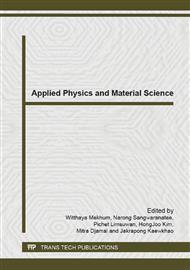p.471
p.479
p.483
p.487
p.491
p.495
p.499
p.504
p.508
A New Chaotic Signal Generation of a Series Microring Resonator for Optical Communication
Abstract:
We propose a new method using light pulses tracing in a micro ring resonator, where the randomly digital codes can be performed. The chaotic signals can be generated and formed by the logical pulses by using the signal quantizing method, which can be randomly coded by controlling the specific optical input coupling powers, i.e. coupling coefficient (κ) and ring radii. Simulation results when the ring radius used are between 7-10.0 μm, and the other selected parameters are close to the practical device values that are presented and discussed. The random codes can be generated by the random control of coupling powers, which can be transmitted and retrieved via the design filters by the specific clients. We can be controlled input power used are between 2.0 and 5.0 mW, whereas the quantizing threshold powers and the traveling roundtrips are 0.3–0.4 mW and 8000–10,000, respectively.
Info:
Periodical:
Pages:
491-494
Citation:
Online since:
June 2014
Authors:
Keywords:
Price:
Сopyright:
© 2014 Trans Tech Publications Ltd. All Rights Reserved
Share:
Citation:


